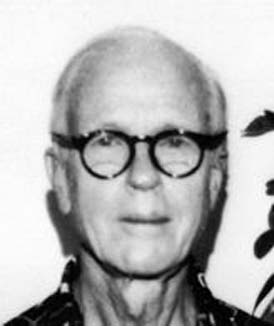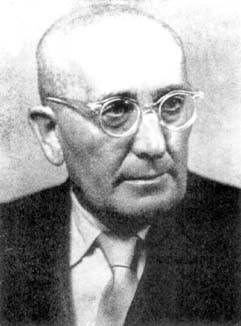<Back to Index>
- Mathematician Hassler Whitney, 1907
- Mathematician Eduard Čech, 1893
PAGE SPONSOR

Hassler Whitney (March 23, 1907 – May 10, 1989) was an American mathematician. He was one of the founders of singularity theory, and did foundational work in manifolds, embeddings, immersions and characteristic classes.
Hassler Whitney was the son of First District New York Supreme Court judge Edward Baldwin Whitney and Josepha (Newcomb) Whitney, the grandson of Yale University Professor of Ancient Languages William Dwight Whitney, the great - grandson of Connecticut Governor and US Senator Roger Sherman Baldwin, and the great - great - great - grandson of American founding father Roger Sherman.
Hassler Whitney's maternal grandparents were astronomer and celestial mechanician Simon Newcomb and Mary Hassler Newcomb (the granddaughter of the first superintendent of the Coast Survey Ferdinand Hassler).
He married Margaret R. Howell, May 30, 1930; children: James Newcomb, Carol, Marian; married Mary Barnett Garfield, January 16, 1955; children: Sarah Newcomb, Emily Baldwin; and married Barbara Floyd Osterman, February 8, 1986.
He received his Ph.D. from Yale University in 1928; his Mus.B., 1929; Sc.D. (Honorary), 1947; and Ph.D. from Harvard University, under George David Birkhoff, in 1932.
He was Instructor of Mathematics at Harvard University, 1930 – 31, 1933 – 35; NRC Fellow, Mathematics, 1931 – 33; Assistant Professor, 1935 – 40; Associate Professor, 1940 – 46, Professor, 1946 – 52; Professor Instructor, Institute for Advanced Study, Princeton University, 1952 – 77; Professor Emeritus, 1977 – 89; Chairman of the Mathematics Panel, National Science Foundation, 1953 – 56; Exchange Professor, Collčge de France, 1957; Memorial Committee, Support of Research in Mathematical Sciences, National Research Council, 1966 – 67; President, International Commission of Mathematical Instruction, 1979 – 82; Research Mathematicians, National Defense Research Committee, 1943 – 45; Construction of the School of Mathematics. Recipient, National Medal of Science, 1976, Wolf Prize, Wolf Foundation, 1983; and a Steele Prize in 1985.
He was a member of the National Academy of Science; Colloquium Lecturer, American Mathematical Society, 1946; Vice President, 1948 – 50 and Editor, American Journal of Mathematics, 1944 – 49; Editor, Mathematical Reviews, 1949 – 54; Chairman of the Committee vis. lectureship, 1946 – 51; Committee Summer Instructor, 1953 – 54; Steele Prize, 1985, American Mathematical Society; American National Council Teachers of Mathematics, London Mathematical Society (Honorary), Swiss Mathematics Society (Honorary), Académie des Sciences de Paris (Foreign Associate); New York Academy of Sciences.
Whitney's earliest work, from 1930 to 1933, was on graph theory. Many of his contributions were to the graph coloring, and the ultimate computer assisted solution to the four - color problem relied on some of his results. His work in graph theory culminated in a 1935 paper, where he laid the foundations for matroids, a fundamental notion in modern combinatorics and representation theory.
Whitney's lifelong interest in geometric properties of functions also began around this time. His earliest work in this subject was on the possibility of extending a function defined on a closed subset of ℝn to a function on all of ℝn with certain smoothness properties. A complete solution to this problem was found only in 2005 by Charles Fefferman.
In a 1936 paper, Whitney gave a definition of a smooth manifold of class C r, and proved that, for high enough values of r, a smooth manifold of dimension n may be embedded in ℝ2n+1, and immersed in ℝ2n. (In 1944 he managed to reduce the dimension of the ambient space by 1, provided that n > 2, by a technique that has come to be known as the "Whitney trick".) This basic result shows that manifolds may be treated intrinsically or extrinsically, as we wish. The intrinsic definition had been published only a few years earlier in the work of Oswald Veblen and J.H.C. Whitehead. These theorems opened the way for much more refined studies: of embedding, immersion and also of smoothing: that is, the possibility of having various smooth structures on a given topological manifold.
He was one of the major developers of cohomology theory, and characteristic classes, as these concepts emerged in the late 1930s, and his work on algebraic topology continued into the 40s. He also returned to the study of functions in the 1940s, continuing his work on the extension problems formulated a decade earlier, and answering a question of Schwartz in a 1948 paper On Ideals of Differentiable Functions.
Whitney had, throughout the 1950s, an almost unique interest in the topology of singular spaces and in singularities of smooth maps. An old idea, implicit even in the notion of a simplicial complex, was to study a singular space by decomposing it into smooth pieces (nowadays called "strata"). Whitney was the first to see any subtlety in this definition, and pointed out that a good "stratification" should satisfy conditions he termed "A" and "B". The work of René Thom and John Mather in the 1960s showed that these conditions give a very robust definition of stratified space. The singularities in low dimension of smooth mappings, later to come to prominence in the work of René Thom, were also first studied by Whitney.
His book Geometric Integration Theory gives a theoretical basis for Stokes' theorem applied with singularities on the boundary and later inspired the generalization found by Jenny Harrison.
These aspects of Whitney's work have looked more unified, in retrospect and with the general development of singularity theory. Whitney's purely topological work (Stiefel – Whitney class, basic results on vector bundles) entered the mainstream more quickly.

Eduard Čech (29 June 1893 – 15 March 1960) was a Czech mathematician. His research interests included projective differential geometry and topology. He is especially known for the technique known as Stone - Čech compactification (in topology) and the notion of Čech cohomology. He was the first to publish a proof of Tychonoff's theorem in 1937.
He was born in Stračov, then in Bohemia, Austria - Hungary, now in the Czech Republic. His father was Čeněk Čech, a policeman, and his mother was Anna Kleplová.
After attending the gymnasium in Hradec Králové, Čech was admitted to the Philosophy Faculty of Charles University of Prague in 1912. In 1915 he was drafted into the Austro - Hungarian Army and participated in World War I, after which he completed his undergraduate degree in 1918. He received his doctoral degree in 1920 at Charles University; his thesis, titled On Curves and Plane Elements of the Third Order, was written under the direction of Karel Petr. In 1921 - 1922 he collaborated with Guido Fubini in Turin, Italy. He taught at Masaryk University in Brno and at Charles University. Ivo Babuška, Vlastimil Dlab, Zdeněk Frolík, Věra Trnková and Petr Vopěnka have been doctoral students of Čech.
He attended the First International Topological Conference held in Moscow 4-10 September 1935. He made two presentations there: "Accessibility and homology" and "Betti groups with different coefficient groups".
He died in Prague in 1960.